|
Considering the
total number of species, diversity, available selection, and
beauty of Labrid fish in the marine aquarium trade, it should
be no surprise that every few months this column would feature
a new genus of wrasses. Thus, the genus Coris will
represent the first edition of wrasses in 2005. This genus
is diverse: some of its members do well in reef aquariums,
while others would terrorize the same system. Likewise, a
few species remain small enough to be easily kept in many
home aquariums, while other members of this genus can become
100-pound behemoths. Clearly, careful selection is necessary
to maintain these attractive fish that the marine aquarium
trade has dubbed the Rainbow Wrasses.
|
Coris are known for their striking colors and
patterns. A female C. gaimard is seen
here, photographed in a home aquarium. Photo courtesy
of Greg Rothschild.
|
Meet the Family
Coris
is one genus in the second largest marine fish family, Labridae.
This huge family contains more than 65 genera and 460 species.
The fishes placed in the Labridae family characteristically
use their pectoral fins extensively for swimming, rarely using
their tail, and then usually as a means of escaping danger.
Some species are among the most popular marine aquarium fishes
found in home aquariums.
|
An attractive and smaller species of Coris is
C. pictoides, the Pixy wrasse. It can be found
occasionally in aquarium stores as this species is wide-ranging
and plentiful in the Pacific, especially near the Philippines.
Photo courtesy of John Randall.
|
At the beginning of the 19th century Lacepede (1801) introduced
the new genus Coris. His description was based on collections
of a wide-ranging Indo-Pacific species, C. aygula.
Although this fish was labeled as the first species
of the genus, it was, in fact, the second fish of the genus
to be described. The first described species was initially
assigned to the genus Labrus as Labrus julis
(Linnaeus, 1758). As the first person to describe animals
using the binomial nomenclature now in use, Linnaeus often
was too inclusive, lumping together animals that later specialists
would separate into different groups. As an example, Lacepede
created the genus Coris and provided a proper home
for this species. Fish of species in this genus are notable,
however, for undergoing a magnificent color change as they
age from juveniles to adults. Despite their easy generic classification,
ichthyologists were often bewildered by the task of assigning
a species name because of their odd color forms. As a result,
many species have been described many times. For instance,
C. aygula has 11 synonyms assigned to it, while C.
julis has 15 (Randall, 1999). All told, once sorted and
studied, the genus Coris tallies 27 species.
|
Labridae
|
|
·
Coris
|
|
o
atlantica
|
|
o auricularis
|
|
o
aurilineata
|
|
o
aygula
|
|
o
ballieui
|
|
o
batuensis
|
|
o
bulbifrons
|
|
o
caudimacula
|
|
o
centralis
|
|
o
cuvieri
|
|
o
debuen
|
|
o
dorsomacula
|
|
o
flavovittata
|
|
|
|
o
formosa
|
|
o
gaimard
|
|
o
hewetti
|
|
o
julis
|
|
o
marquesensis
|
|
o
musume
|
|
o
nigrotaenia
|
|
o
picta
|
|
o
pictoides
|
|
o
roseoviridis
|
|
o
sandageri
|
|
o
schroederii
|
|
o
variegata
|
|
o
venusta
|
|
Missing from the above list are fish from
the genera Pseudocoris and Ophthalmolepis. In
the past, the five species of Pseudocoris and the single
species of the genus Ophthalmolepis were regarded as
members of the genus Coris. The lunate caudal fin found
in Pseudocoris, however, is absent in all Coris
species. Additionally, their propensity to consume zooplankton
from mid-water is unlike the feeding characteristics typical
of Coris. Furthermore, the different dining lifestyle
is further revealed by a few montable features, most notably
a reduced jaw and pharyngeal dentition, aiding in the capture
of swimming or passing food items. In much the same fashion,
a different vertebrae and dorsal ray count, along with larger
dorsal and anal pterygiophores (the bones with which the fins
join the body), have helped to keep Ophthalmolepis
as a distinctly recognized genus as well.
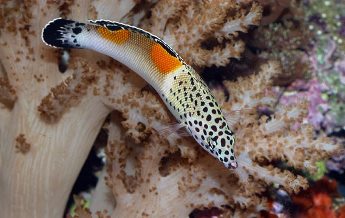 |
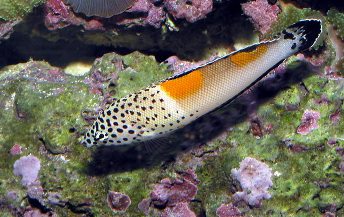 |
Coris aygula makes an attractive addition to a home
aquarium as a juvenile, but is not the best option. They can
reach
a size of around 2'. Photos courtesy of Greg Rothschild.
Little variation is present in their dorsal, anal, and pectoral
fin ray counts. Generally, Coris species have 12 hard
dorsal rays; however C. batuensis and C. variegata,
possess only 11. Anal rays typically number 12, except for
the two aforementioned species, which may occasionally have
11. Additionally, they almost always have 13 or 14 pectoral
rays, but on rare occasions ichthyologists have noted 12 and
15 as well. The mouth also presents a series of consistent
features that distinguish this genus. A pair of large canine
teeth are located at the tip of both the upper and lower jaws.
These teeth are slightly recurved and fit nicely into one
another when the jaws are closed. Running the length of their
jaws are several rows of teeth. Beginning as large conical
teeth, the outside row gets progressively smaller as the row
extends toward the rear of the mouth. Inside these conical
teeth are small, molariform teeth, which form several more
irregular rows. The final teeth of note are their pharyngeal
teeth. These bone-crushing teeth are used by several genera
of Labrids, including Macropharyngodon and Halichoeres.
These teeth are especially useful for crushing the hard exoskeleton
of motile invertebrates such as hermit crabs, echinoderms,
and mollusks (Randall, 1999).
A beautiful juvenile Coris wrasse that is un-identifiable
in its youth from a photo alone.
It could be either a juvenile of Coris gaimard or
C. cuvierie.
Photo courtesy of Greg Rothschild.
Randall (1999) further organized the genus
with a single complex (listed below) of closely related species.
Although not listed in the Caudimacula complex, it
is believed C. hewetti may belong to this complex
due to its juvenile coloration, which is similar to other
species in the Caudimacula complex. Additionally, C.
ballieui, C. centralis and C. flavovittata
are not closely related to any of the other Coris species;
thus they are listed as relics. Finally, it's entirely possible
that further DNA research will prove that C. musume
and C. picta are closely-related enough to consider
them subspecies. For aquarists, however, given most species'
striking coloration, most anyone equipped with a photographic
identification guide can easily make an accurate ID in most
cases.
|
Caudimacula
Complex:
|
|
C.
debueni
|
|
C.
dorsomacula
|
|
C.
roseoviridis
|
|
C.
venusta
|
|
C.
caudimacula
|
Endemic to Hawaiian waters and therefore called the Hawaiian
Rainbow wrasse, Coris flavovittata looks similar to
cleaner wrasses of the genus Labroides and as juveniles
are known to clean adult fish of parasites. Juvenile (top
left), male (top right & bottom left),
female (bottom right). Photos courtesy of John Randall.
In the Wild
Coris
species are represented in both the Atlantic and the Pacific
Oceans, although they are considerably more plentiful in Pacific
waters. It was originally believed that only one species,
Coris julis, was found in the Atlantic, having an extensive
geographical range extending from Norway to the equator. However,
Seret and Opic (1986) discovered that this wide-ranging Atlantic
species was actually two species and therefore named one species
C. atlantica. It is now believed that any Coris
species located south of the Verde Islands are C. atlantica.
All remaining Coris species are found in Pacific waters.
Despite the wide range of the two Atlantic species, the Pacific
species remain localized with a number of species having been
collected from only one or two locales. Coris nigrotaenia
is one such species, known only from the Gulf of Aden; Coris
hewetti is another such example, having been found only
at the Marquesas Islands. Perhaps the rarest of all species
is C. debueni, as it is known only from Easter Island.
A Hawaiian endemic is also present in this genus. Although
it's more prevalent at the northwestern edge of this chain
of islands, C. flavovittata can be found extending
all the way northward to Kure Island. Because of the often
limited distribution of Pacific species, it is perhaps ironic
that C. aygula has the largest distribution of the
genus. Species have been collected from the Red Sea and eastern
coast of Africa, from southern Japan to southern Australia,
and as far east as the Ducie Atoll.
The majority of Coris wrasses can be found in fairly
shallow water as juveniles. It is common for specimens to
be numerous at depths of only 5 - 10'. The larger individuals,
however, generally prefer water slightly deeper, often between
40 - 120' deep. Deeper dwelling individuals exist, though,
as submarine observations have identified Coris gaimard
as deep as 240' (Chave and Mundy, 1994), and deep water fish
traps have captured C. ballieui at these same depths
(Randall, 1999).
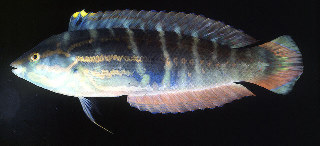 |
Coris dorsomacula, called the Pink-lined Rainobow
wrasse within the aquarium trade, is a wide-ranging
Pacific species. Although not regularly collected for
the hobby, juveniles do have a tendency to appear at
the local stores on occasion. Top photo (male),
bottom (female). Photos courtesy of John Randall.
|
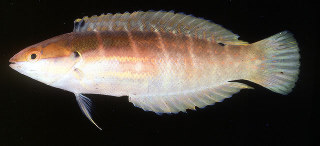 |
Fringing reefs, on either the ocean side or lagoonal side,
are the overwhelming choice of the fish in this genus, although
they occasionally can be found roaming grass beds. Individuals
will cruise open stretches of sand adjacent to the reefs.
While the reef presents various food options, the sand offers
Coris species their security. It is a delicate balance
that they master extremely well. Rainbow wrasses utilize the
sandbed both for sleeping and safety, and they are noted to
maintain several preferred "sand diving" areas throughout
their home range. They will remove larger stones and rocks
leaving only a soft, micro-fine sandbed which allows for easy
"sand diving." As nightfall approaches, the wrasse
will retire into the sand for the evening only to rise again
shortly after sunrise. Likewise, it uses this same disappearing
trick to escape imminent danger. When threatened, the wrasse
can dive into the sand literally "in the blink of an
eye." The largest adults are an exception to this rule;
they may opt, instead, to wedge themselves in between rocks.
Presumably, the adult fishes' large size may hinder their
attempts to disappear quickly.
|
Another Coris wrasse noted to clean adult fish,
even other adult Coris species, is C. sandeyeri,
also called the King Rainbow wrasse. A male is seen
in the top photo, a juvenile in the bottom
picture. Photos courtesy of John Randall.
|
|
|
|
As mentioned earlier, the morphological
features of the Rainbow wrasse's mouth enable it to capture
and consume hard-shelled invertebrates. Their lifestyle and
security dictate the need for open stretches of sandbed. It
should be no surprise, therefore, to learn their stomach contents
are often filled mostly with sand-dwelling gastropods. In
one study a 4" Coris aygula had stomach contents
consisting of over 60% gastropods, 10% hermit crabs, 10% isopods
and 10% chitons (Sano et al, 1984). Adult individuals
of the same species over 10" long have been noted to
consume mostly hermit crabs and mollusks (Randall et al,
1990). Juveniles of another species, C. gaimard, are
noted to consume mollusks for over 70% of their diet (Hobson,
1974), while the adults shift to a more varied diet of brachyuran
crabs (33%), gastropods (31%), pelecypods (22%) and hermit
crabs (12%) (Randall, 1999). Rainbow wrasses are not afraid
to exert some energy to look for food, either. Adults will
regularly flip over rocks searching for food. Additionally,
juveniles will often act as cleaner fish by removing parasitic
infections from larger fishes (Ayling and Cox, 1982).
The majority of Coris species remain in small harems
consisting of a single large adult male and several smaller
juvenile and female fish. Species known to cruise lagoons,
however, are more often seen as solitary individuals. As with
all protogynous hermaphrodites, the female's ovaries will
become virtually non-existent while the male sexual reproductive
organs, most notably the testes, will mature into functional
organs. This, of course, only happens within a harem after
the male's demise. However, not all male Coris wrasses
are the result of a female-to-male sex change. Coris julis
has been noted to be diandric. This means that the genus has
been shown to have both primary and secondary males, or in
other words, some males are, in fact, born as males and are
not the result of a female-to-male sex change. Up to 30% of
the Coris julis sampled were found to be primary males
that displayed a drab initial phase (normally, this initial
color phase is associated with females) (Roede, 1966; Randall,
1999). As of yet, none of the Pacific species have been shown
to be diandric.
|
|
|
|
|
The most common fish found around Easter Island is Coris
debueni. However, this also happens to be the only
locality this fish is known from. Thus, it was dubbed
the Easter Island Rainbow wrasse. Top left (female),
top right (male), bottom left (juvenile).
Photos courtesy of John Randall.
|
In the Home Aquarium
If I were to say
that a Coris species wrasse could do well in an aquarium,
it could be easily taken as an understatement. The vast majority
of Rainbow wrasses can readily make the adjustment from wild
reefs to captive conditions with minimal stress. Just like
any other marine fish, however, the proper conditions for
captive care need to be established prior to realizing success.
Also, despite the success of establishing a healthy Rainbow
wrasse in an aquarium, it might also turn into a traumatic
experience for the aquarist. A few basic precautions will
ensure that both hobbyist and fish will benefit from the relationship.
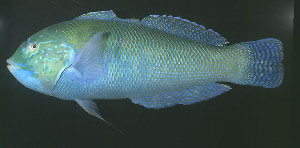 |
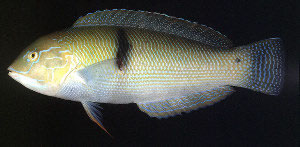 |
|
Named the Black-bar Rainbow wrasse for obvious reasons,
Coris nigrotaenia is endemic to the southern
stretches of the Gulf of Oman where they prefer excessive
water current off of rocky points. Left (male),
right, (female). Photos courtesy of John Randall.
|
For starters, a typical reef aquarium is likely a poor habitat
for a new Coris wrasse. Well, let me rephrase that
- it is likely a great place to put a Coris wrasse,
but the aquarium owner will likely not enjoy the outcome.
The aquarium's cleaning crew will be an excellent, much needed
snack for the new wrasse to work on as it begins to settle
into its new home and adjust to eating prepared foods.
|
The African Rainbow wrasse, Coris cuvieri, is
a wide ranging and beautiful species, likely accounting
for its regularity within the aquarium trade. Male (top),
juvenile (bottom). Photos courtesy of John Randall.
|
|
|
|
Assuming the aquarist's intention is not to feed the new
wrasse a steady diet of snails and hermit crabs, the fish
will likely wind up in a non-reef aquarium, or at least one
that does not contain motile invertebrates as either decorative
inhabitants or as a janitorial crew. However, this natural
diet of the Rainbow wrasse will need to be supplemented if
its natural prey is not available. Recommended food items
would include krill, mysid species shrimp, clam or mussel
meat, and just about any other commercially available food
designed with the carnivore in mind. A minimum of two large
feedings per day should be considered for adults, with more
frequent feedings for juveniles as the young, active wrasses
expend a good amount of energy throughout the day.
The aquarium décor is another consideration. Rock
wall designs, which feature a large portion of sandbed, will
ease their adjustment to captivity. These wrasses spend the
vast majority of their daylight hours roaming open water.
Densely packed rockwork is not terribly important, as long
as at least some suitable shelter is provided. Even so, it
is unlikely to be used often, possibly more so as a hunting
ground than as a hiding place. Juveniles are more likely to
concern themselves with the rockwork, however, as they may
not feel completely comfortable. Aquascape the aquarium accordingly,
ensuring that both plenty of open sand and plenty of hiding
places are available.
|
|
The Central Pacific wrasse, Coris centralis,
has been found only around the Line Islands including
Washington, Fanning, and Christmas Islands. The top
photo is a female, the male is in the bottom
picture. Photos courtesy of John Randall.
|
|
|
Speaking of hiding places, the wrasse will need a sandbed
several inches deep into which it can dive. This would include
mostly oolitic sand without much rubble rock or crushed oyster
shell. In aquariums containing a mixture of sand grain sizes
and grades, the wrasse will likely do a little rearranging
of its own until it has created areas of soft sand, ready
for its immediate disappearance. Every night when the Rainbow
wrasse retires, it dives into the sandbed, leaving no telltale
signs except for a small cloud of sand dust, which quickly
dissipates. It is there that it sleeps until the sun rises
again, at which time it slowly rises out of the sandbed and
inspects its surroundings before fully emerging. Sand sometimes
sticks to its slime coat for a few minutes after waking, but
will usually be blown off by water currents in short order.
You can expect your Coris wrasse to go to sleep, and
wake up, at nearly the same time each day. Their internal
clock is amazingly predictable. At first, this might be a
problem, as they will initially still be functioning on their
native Indo-Pacific (or Atlantic) time. As the days and weeks
pass, though, the fish will slowly readjust their schedule
to more closely resemble the tank's photoperiod. Finally,
larger pieces of rubble should be included as "play toys"
for the fish. Chances are good that the wrasse will pick up,
flip over, toss around, or even swim around with these larger
pieces of rock. They will be a source of natural foods as
it hunts underneath the overturned rocks, as well as seemingly
using them as a toy for passing the time. Indeed, it is likely
that this characteristic will also entertain the aquarist.
The size of the aquarium is a serious consideration. Many
of these species become much too large for all but the biggest
of home aquariums. A foot-long actively swimming and aggressively
eating wrasse is nothing to be taken lightly; it needs suitably
large housing. Juvenile Coris wrasses may do well in
4 - 6' long aquariums for a brief period, but if fed appropriate
amounts of food, the wrasse will quickly grow into a very
large fish, almost certainly requiring a 10' long aquarium
as an adult so that even these smaller species can spread
their "wings," or pectoral fins. Quite simply, the
larger species are not suitable for home aquaria.
|
|
The Lined Rainbow wrasse, known among ichthyologists
as Coris ballieui, is an endemic of the Hawaiian
Islands. The female coloration was mistakenly named
C. rosea. The top photo is a male, the
bottom picture is a female. Photos courtesy of
John Randall.
|
|
|
Suitable tankmates include a lot of the larger or active
fish appropriate for reef aquariums. Surgeonfish, butterflies,
angelfish, Anthias and damselfish are all good options. Those
fish are both active enough to compete for food and large
enough to defend themselves, if needed. In most instances,
however, the wrasse will not be the aggressor. It will generally
mind its own business, going about its never-ending search
for food. Smaller fish will be at risk of attack or harassment,
though, so it may be best to avoid small gobies, flasher wrasses
or dartfishes. Additionally, slow feeders may not be able
to compete with the wrasse at feeding time and therefore either
direct feeding will be required or the aquarist should opt
to do without the reticent feeders. Finally, in regards to
fish, it would likely be wise to avoid multiple Rainbow wrasses
in the same aquarium. If you truly desire to the mix species,
however, avoid adding two males. This combination will undoubtedly
result in fierce battles among the males. The addition of
two females, or one male and one female, should work in larger
aquariums.
|
The Batu Rainbow wrasse, Coris batuensis, is
a rarity of the Coris genus as it barely changes
its coloration as it ages from a juvenile, to female,
and finally male. The top left photo is a male,
the top right photo is a female and the bottom
photo is a juvenile. Photos courtesy of John Randall.
|
Compatibility
chart for the genus Coris:
| Fish |
Will
Co-Exist
|
May
Co-Exist
|
Will
Not Co-Exist
|
Notes |
| Angels,
Dwarf |
X
|
|
|
Should
co-exist well. Add fish when they are nearly the same
size. |
| Angels,
Large |
X
|
|
|
Should
co-exist well. Add smaller of the two planned fish first. |
| Anthias |
X
|
|
|
Should
co-exist well. Add the Anthias first. |
| Assessors |
|
X
|
|
Will
mix but the Assessor will remain hidden for the majority
of the time. |
| Basses |
X
|
|
|
Should
co-exist well. |
| Batfish |
X
|
|
|
Should
co-exist well. Batfishes in first. |
| Blennies |
X
|
|
|
Should
co-exist well. Blennies in first. |
| Boxfishes |
X
|
|
|
Should
co-exist well. Boxfishes in first. |
| Butterflies |
X
|
|
|
Should
co-exist well. |
| Cardinals |
X
|
|
|
Should
co-exist well. Cardinals in first. Cardinals may be less
active than normal with the active wrasse present. |
| Catfish |
X
|
|
|
Should
co-exist well. |
| Comet |
X
|
|
|
Should
co-exist well. |
| Cowfish |
X
|
|
|
Should
co-exist well. Cowfish in first. |
| Damsels |
X
|
|
|
Should
co-exist well. Wrasse in first. |
| Dottybacks |
X
|
|
|
Should
co-exist well. |
| Dragonets |
X
|
|
|
Should
co-exist well. Consider a refugium for smaller aquariums. |
| Drums |
X
|
|
|
Should
co-exist well. |
| Eels |
X
|
|
|
Should
co-exist well. |
| Filefish |
X
|
|
|
Should
co-exist well. |
| Frogfish |
|
X
|
|
Large
frogfish can consume small wrasses. |
| Goatfish |
X
|
|
|
Should
co-exist well. |
| Gobies |
|
X
|
|
Feeding
the gobies directly will likely be necessary. |
| Grammas |
X
|
|
|
Should
co-exist well. Grammas in first. |
| Groupers |
X
|
|
|
Should
co-exist well. Add species at the same general size. |
| Hamlets |
X
|
|
|
Should
co-exist well. |
| Hawkfish |
X
|
|
|
Should
co-exist well. |
| Jawfish |
|
X
|
|
Coris
wrasse may hinder the natural activity of the jawfish.
Add jawfish first. |
| Lionfish |
X
|
|
|
Should
co-exist well. Wrasse in first. |
| Parrotfish |
X
|
|
|
Should
co-exist well. |
| Pineapple
Fish |
X
|
|
|
Should
co-exist well. |
| Pipefish |
|
|
X
|
Pipefish
require an aquarium to themselves. |
| Puffers |
X
|
|
|
Should
co-exist well. Puffers in first. |
| Rabbitfish |
X
|
|
|
Should
co-exist well. |
| Sand
Perches |
X
|
|
|
Should
co-exist well. |
| Scorpionfish |
X
|
|
|
Should
co-exist well. |
| Seahorses |
|
|
X
|
Seahorses
do best when given their own aquarium. |
| Snappers |
X
|
|
|
Should
co-exist well. |
| Soapfishes |
X
|
|
|
Should
co-exist well. Soapfishes in first. |
| Soldierfish |
X
|
|
|
Should
co-exist well. |
| Spinecheeks |
X
|
|
|
Should
co-exist well. |
| Squirrelfish |
X
|
|
|
Should
co-exist well. |
| Surgeonfish |
X
|
|
|
Should
co-exist well. |
| Sweetlips |
X
|
|
|
Should
co-exist well. Add fish when generally the same size. |
| Tilefish |
|
X
|
|
Tilefish
in first. Natural activity may be hindered by presence
of the wrasse. |
| Toadfish |
|
|
X
|
Toadfish
can consume small wrasses. |
| Triggerfish |
|
X
|
|
The
more aggressive triggerfish should be avoided. Wrasse
added first. |
| Waspfish |
X
|
|
|
Should
co-exist well. |
| Wrasses |
|
X
|
|
Avoid
two male wrasses in the same aquarium. |
Note: While many of the fish listed
are good tank mates for members
of the genus Coris, you should research each fish individually
before adding it to your aquarium. Some of the mentioned fish
are better left in the ocean or for advanced aquarists.
|
Coris caudimacula, the Tail-spot wrasse, inhabits
alga-rich areas, mostly prefering sea grass beds. The
largest percentage of the 8" adult's diet is composed
of amphipods. The top left photo is a female,
the top right photo is a male and the bottom
photo is a juvenile. Photos courtesy of John Randall.
|
As should be rather obvious at this point,
motile invertebrates are best avoided unless you are purposely
adding them as supplemental food reserves. Conversely, corals
should be left alone. I say "should be" because,
on occasion, the wrasse may decide to move or flip a coral
over in its search for food. This is usually not cause for
much concern, but in rare instances, the wrasse may actually
prefer the coral to be upside-down, and thus any attempts
by the hobbyist to right the coral will be answered with a
prompt reversal as soon as the coast is clear. Clearly, additional
measures, such as securing the coral with epoxy, will need
to be taken if this happens to you.
|
Coris bulbifrons has the most uniquely shaped
head found among the largest of Coris wrasses.
As such, it has been awarded the common name of Doublehead
Rainbow wrasse. The top photo is a juvenile, the
bottom left photo is a male, the bottom right
photo is a female. Photos courtesy of John Randall.
|
Meet the Species
Only a handful of
Coris wrasses appear with any regularity in the aquarium
trade. This is probably a good thing simply because the adult
size of many of these fish is more than most hobbyists bargained
for or expected. Perhaps the most readily identifiable species
is Coris aygula, whose availability is probably assisted
by having the genus' largest wild distribution. The Twin-Spot
or Clown Coris wrasse is remarkably beautiful as a juvenile,
and often lures unsuspecting aquarists into purchasing it
on impulse. However, the cute juvenile grows into a huge adult
nearly 2' long. Rumors abound of individuals in this species
reaching a length of over 3', but when several hundred of
these species were collected for scientific research, the
largest one speared was just under 24" (Randall, 1999).
Furthermore, Randall (1999) questions the reality
of any Coris that is claimed to be over 700mm (27.5
inches). Regardless, it remains among the two largest species
of the genus.
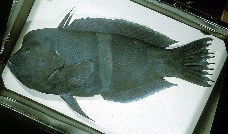 |
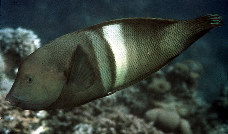 |
|
|
|
Coris aygula is extremely attractive as a juvenile,
thus accounting for its popularity within the aquarium
trade. Their large adult size and voracious appetite
should eliminate the Twin-Spot wrasse from consideration
for most hobbyists, however. A male is seen in the top
left photo and a juvenile in the bottom
picture. Photos courtesy of John Randall.
|
The Queen of the family is Coris formosa. Plenty of
confusion exists over this name, however. In his most recent
revision, Randall (1999) chooses the name C. frerei
at "the insistence of a colleague." After publication,
however, Randall discovered his error and corrected himself
in Parenti and Randall (2000). Therefore, research will likely
have to incorporate both names to ensure locating all available
information. General hobby literature has incorrectly stated
that individuals reach up to 24"; ichthyologists, however,
have recorded only a 17" individual as the largest from
a sample size of 50 fish.
|
The Queen Rainbow wrasse has much confusion surrounding
its name awarded by ichthyologists, but as of now it
is recognized as Coris formosa and not C.
frerei. Female (top left), male (top right),
juvenile (bottom). Photos courtesy of John Randall.
|
The final, commonly occurring Coris wrasse in captivity
is C. gaimard. Adults of this species, commonly called
the Yellowtail Coris wrasse, will reach 10" in length.
Their size may seem to indicate that they may be a better
option for home aquariums, but keep in mind that adults have
been noted to consume nearly 65% of their diet in the form
of snails and crabs.
|
|
|
Very little difference can be detected between juveniles
of Coris gaimard (above) and C. cuvieri,
but as adult coloration begins to unfold, the differences
are clearly noted. At one point these two species
were regarded as sub-species. The top right
photo is a female, the male is seen to the right.
Photos courtesy of John Randall.
|
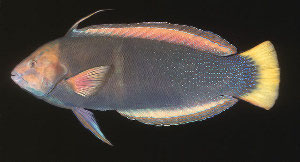 |
One last word regarding Coris wrasses in regards to
imposters… Many online and local retailers of marine
fish have a tendency to label fish by a common name only.
Without getting into a deep discussion regarding the errors
involved in using common names, such a practice is typical
with the Coris name. Several fish are commonly sold
as the Yellow Coris wrasse or Green Coris wrasse when, in
fact, these fish are not Coris wrasses whatsoever.
For aquarists, the trouble arises when these fish have different
captive care requirements than do the true Coris
wrasses. Providing the proper living conditions begins with
knowing precisely which fish you have purchased. Only then
will your research be accurate and helpful. It would be wise,
therefore, to use caution when shopping and seeing fish labeled
as a various color of Coris wrasse.
Halichoeres leucoxanthus, seen here, is often mistakenly
confused with
a Coris wrasse by wholesalers and local fish stores.
Photo courtesy of Travis Staut.
Conclusion
Rainbow wrasses
come in a variety of sizes and colors. Many choices are offered
in aquarium stores, but not all of them will make the best
inhabitant for your aquarium. With careful selection a hobbyist
can enjoy years of success with these interesting and beautiful
fish. Choosing incorrectly can, at best, lead to a fish outgrowing
the aquarium and, at worst, a wrasse that causes a tremendous
amount of destruction. Astute aquarists will make their choices
wisely.
Yet another endemic species, Coris venusta, or the
Elegant Rainbow
wrasse, can be found only around the Hawaiian Islands.
Photo courtesy of John Randall.
|

